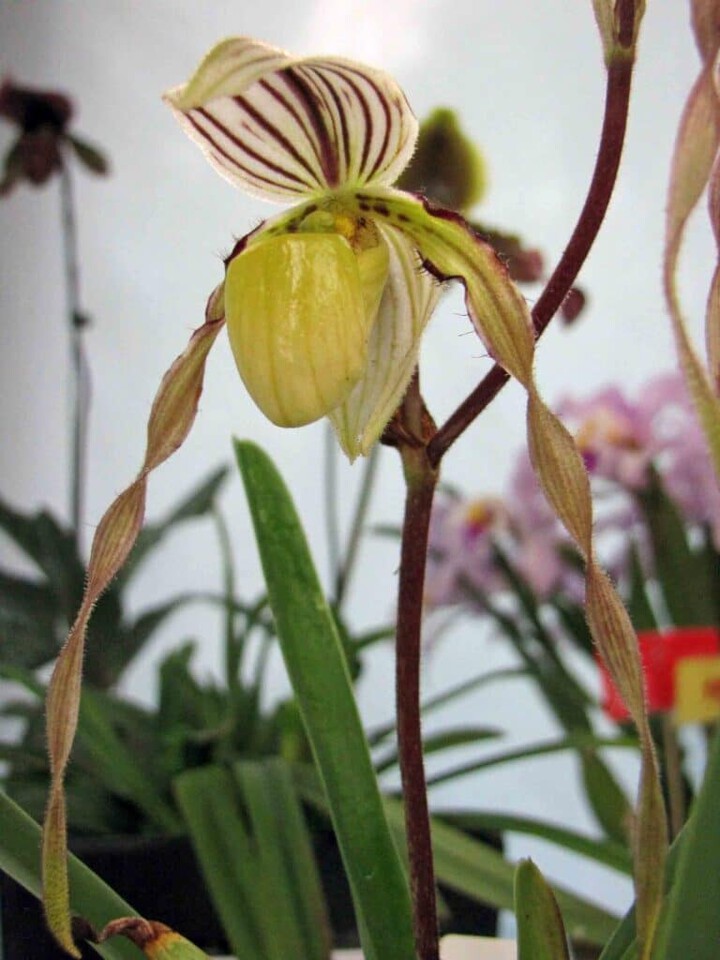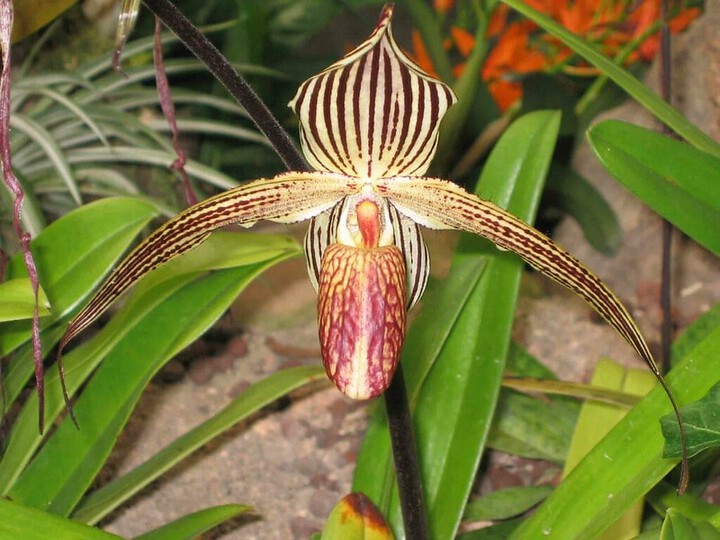Paphiopedilums, otherwise known as lady slippers orchids or Venus’ Slipper orchids, are ornamental plants that you can easily recognize even from afar. Of all orchid types, they have the most prominent pouch-like lip that resembles a slipper, hence the name.
Like other popular orchids, such as the moth orchids, cattleyas, and dendrobiums, these gardener-favorites come in a myriad of flower colors, including yellow, pink, red, brown, and green. Here are some useful facts about paphiopedilum orchids and a guide on how to grow them.
Facts About Paphiopedilum Orchids
Lady slippers orchids are native to the Philippines and other parts of Southeast Asia. They can also be found in Northern India and Southern China. The majority of plants in this genus are semi-terrestrial, but some species are terrestrial or epiphytes (1).
The genus name Paphiopedilum comes from the Greek word pedilon, which means “slipper,” referring to the flower’s notable slipper-like labellum or lip (1).
Plant Description
Orchids from the Paphiopedilum genus are long-bloomers. They flaunt attractive flowers that last for more than six to eight weeks from autumn to spring. Most paphs produce one flower per spike, but some species showcase multiple blooms on a single stem. The flower characteristics, sizes, and colors greatly vary depending on the species.
The leaves of lady slipper orchids can either be solid green or mottled depending on the species. Generally, solid green-leaved paphiopedilum orchids are cool growers, while mottled-leaved types are warm growers.
Popular Paphiopedilum Orchids Species
Paphiopedilum barbigerum
Common name: The Beard Carrying Paphiopedilum
The Beard Carrying Paphiopedilum (P. barbigerum) are species of paphs that are mostly located in isolated areas in China. Their narrow, medium green leaves grow up to only about 8 inches, while the flower stalks reach about 2.5 inches tall. The flowers of this popular orchid differ in colors ranging from red to brown, pink, peach, and light yellow (1).
Paphiopedilum philippinense
Common name: Philippine Paphiopedilum
The Philippine Paphiopedilum, a large orchid species widely distributed throughout the Philippines, was first discovered in1856 by horticulturist John Gould Veitch (2).
The plants can be terrestrial or epiphytes, growing up to 20 to 50 cm in height. Their leaves are long, elliptic, thick, glossy, green, and grow up to 50 cm long and 5.5 cm wide. You can see their beautiful blooms during summer through fall on a sub-erect inflorescence. Each flower spike typically holds three to five blooms in varying size, reaching up to 20 cm in height.
The Paph. philippinense flowers have yellow color at the base, which eventually turns into purple or dark red, and then the tip portion turns pale to light green. The prominent lip is yellow or brown with distinct brownish-green veins.
Paphiopedilum rothschildianum
Common names: Gold of Kinabalu Orchid, Rothschild’s Slipper Orchid
One of the most renowned and distinct types of slipper orchids is the Gold of Kinabalu orchid, otherwise called the Rothschild’s slipper orchids. Truly captivating, this large-sized species of Paphiopedilum flaunts tall flower spikes, with each inflorescence carrying up to six prominent exotic flowers. What made them unique is that the petals are almost horizontally displayed and feature green and red spot-like patterns.
The Gold of Kinabalu Orchid is among the easiest to grow Paphiopedilums. It originated from Kinabalu Park in Borneo Island, Sabah, Malaysia (3).
Paphiopedilum fowliei
Common name: Fowlie’s Paphiopedilum
Fowlie’s Paphiopedilum (Paph. fowliei) is an orchid species endemic to the island of Palawan in the Philippines. It is one of the two orchids named after a former editor of Orchid Digest and a known Paphiopedilum enthusiast, Dr. Jack Fowlie. The other orchid named after him is the Paphiopedilum jackii.
This particular Paphiopedilum orchid reaches up to 20 cm tall. It features blue-gray mottled leaves that grow up to 14 cm long and 3.5 cm wide. It also showcases up to 25 cm long inflorescence that holds a single flower. The petals, which are distinctly characterized with green and purple veins, form curves in an s-shape.
Paphiopedilum ciliolare
Common name: Short Haired Paphiopedilum
Short-haired paphiopedilum orchids, otherwise known as Paph. ciliolare, are rare orchids endemic to the Philippines. They are considered endangered, with a decreasing population of only about 2,000 to 2,500 mature individuals.
This Paphiopedilum species is small-sized with a terrestrial growth habit. It can be recognized for the narrow, elongated, and mottled dark and pale green leaves that grow about 10 cm to 16 cm long and 2 cm to 5 cm wide. The bloom time is during the summer through fall with an erect, shortly pubescent, single-flowered inflorescence that typically grows up to 25 cm in length.
The species name originated from the Latin word cilium, which means eyelid or eyelash, referring to the distinctive marginal hairs on both petals and sepals of each flower. The flower measures about 7 cm to 9 cm wide.
Paphiopedilum acmodontum
Common Name: Pointed Tooth Paphiopedilum
Another captivating species of slipper orchids are endemic to the Philippines – the Pointed Tooth Paphiopedilum. Specifically, it originated from the Negros Island. It is a warm grower paphiopedilum that blooms in late spring with beautiful flowers that last up to two months.
This medium-sized paphiopedilum species has mottled green leaves that measure up to 18 cm long and 4 cm wide. Each leaf is elliptic-oblong. The plant displays a single-flowered, green with purple spotting inflorescence that reaches up to 35 cm in length. The flowers grow up to about 7 cm to 11 cm in diameter.
The species name comes from the Greek word akme, which means “pointed,” and Latin word dentium, which means “tooth,” referring to the pointed tip at the apex of the flower’s lip or labellum.
Growing Venus Slippers Orchids
Are you interested in growing lady slipper orchids but not sure how to start? Many gardening beginners get a little anxious about growing orchids mainly because they think that these plants are difficult to care for and grow when, in fact, it is a common misconception.
The lady slipper orchids are among the easiest types of orchids to grow. By simply following the basic principle of culture, these plants will reward you with one of the most beautiful blooms that you could grow from the comfort of your home. Continue reading below for some valuable tips on how to grow paphiopedilum orchids.
Light
Paphiopedilums are low-light orchids that do not need as much light as vandas, cymbidiums, and cattleyas. Exposing them to too much direct light may result in reddish tinge on the leaf edges, whereas underexposure may cause difficulty in reblooming and pale leaves.
When grown as houseplants, you can place them in or near a sunny window, but make sure to avoid cold or warm drafts.
Temperature and Humidity
Generally, the lady slippers orchids prefer 75 – 85 degrees F day temperature and 60 – 65 degrees F night temperature. However, note that plants with mottled leaves thrive better under warmer temperatures than their green-leaved counterparts.
As for the humidity requirements, these orchids require 40% to 50% humidity. If your place is not humid enough, you can place the orchid pot in a tray of pebbles with water on the bottom. However, make sure that the roots are not submerged into the water or else rotting may likely occur.
Water
One distinct feature of plants in the Paphiopedilum genus is that they do not have pseudobulbs, a plant part that gives them the capability of storing water. Hence, these plants require a moist but not soggy growing medium and should not be allowed to dry out.
Watering should be made every 5 to 7 days, or at least twice a week. Do this by placing the plant in the sink, allowing lukewarm water to run through the pot for about a minute. Drain the plant entirely to avoid root rot.
Fertilizer
Feeding your paphiopedilum orchids at least once a week with a quarter strength balanced fertilizer (20-20-20) after watering should be sufficient enough. Flush the pot with clear water once a month to remove salt accumulation from fertilization.
Growing Media and Pots
The key to successfully growing a lady slipper orchid plant is to keep a good root system, and you can only do this if you provide it with the right potting medium. The potting medium should not be allowed to dry out, especially since these plants have no pseudobulbs for water storage. A Cypress or Fir Bark-based media with fine particulates are recommended for this type of orchid.
Ideally, paphiopedilum orchids should be repotted once a year or when the plant has outgrown its current pot. Pots made of plastic retain moisture better compared to clay pots.
You Might Like ...